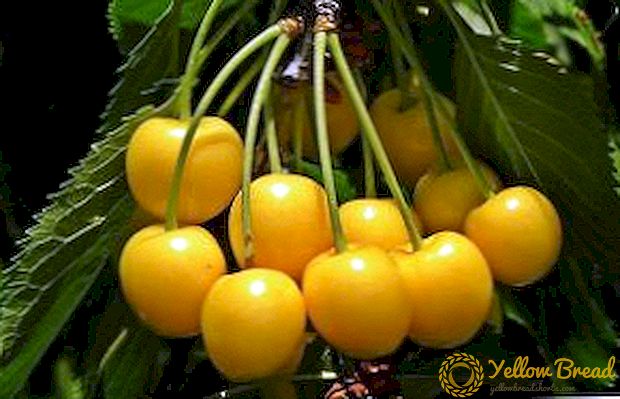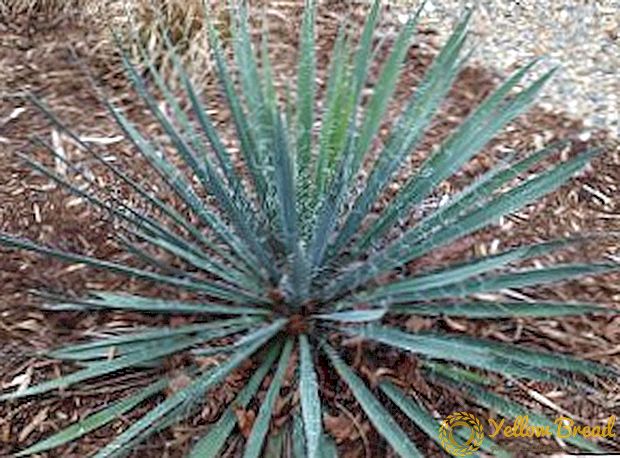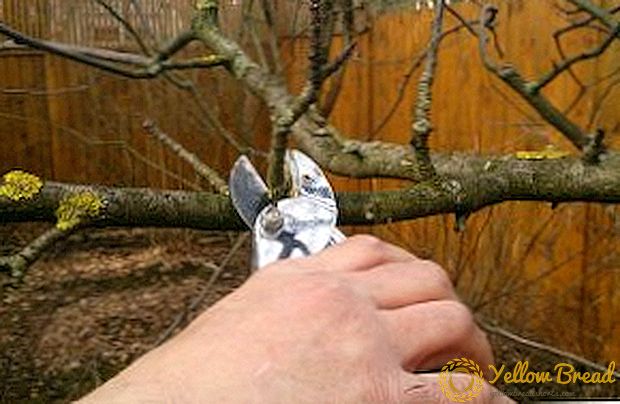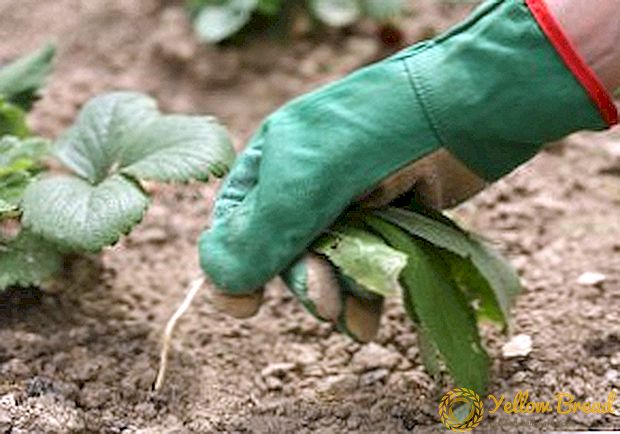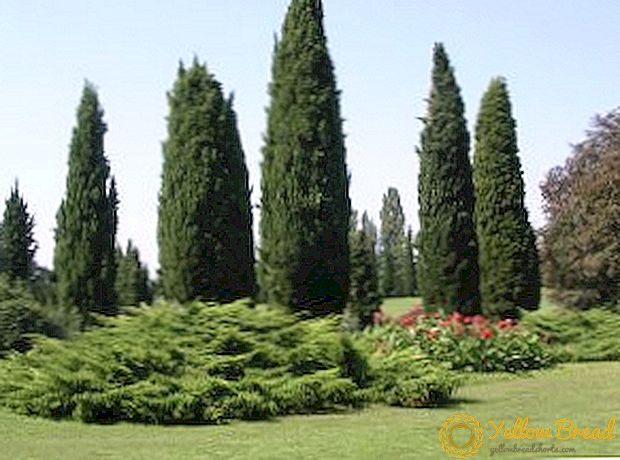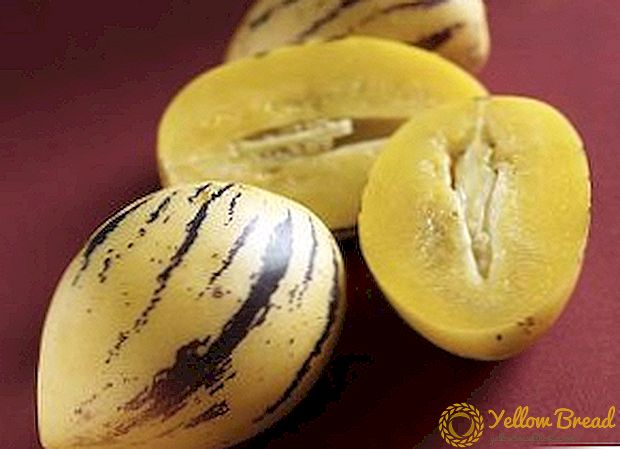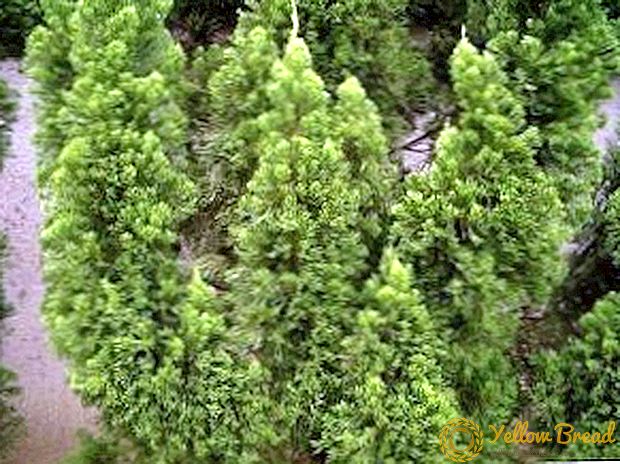 Today we will tell you about the best varieties of Chinese juniper and their differences, so that you can choose the variety you like, coordinate this choice with the climatic conditions in your area and have free time to take care of the plant. You will learn about features of each type and some properties of juniper.
Today we will tell you about the best varieties of Chinese juniper and their differences, so that you can choose the variety you like, coordinate this choice with the climatic conditions in your area and have free time to take care of the plant. You will learn about features of each type and some properties of juniper.
- Chinese juniper: features of the species
- "Stricta"
- Blue Alps
- "Gold Star"
- "Expansa Variegata"
- "Spartan"
- "Kurivao Gold"
- "Blau"
- "Plumoza Aurea"
- "Monarch"
Chinese juniper: features of the species
Chinese juniper is a species of cypress plants whose homeland is China, Manchuria, Japan and North Korea. The plant is a shrub or tree up to 20 m high, shoots are painted in dark green color. The Chinese variety of juniper has two types of needles: needle-shaped and scale-like.
Chinese juniper was introduced to Europe in the early 19th century. In the CIS, this plant first appeared in the Nikitsky Botanical Garden in 1850.
Juniper can withstand temperatures down to -30 ˚C.However, in the first years after landing, frost resistance is very low, which should be remembered when sheltering for the winter.
The plant is not demanding on soil fertility and moisture, however begins to hurt at low humidity.
Chinese juniper can be planted in the following zones: the south-western part of the forest zone, the western and central part of the forest-steppe and steppe zones of the CIS. Best of all juniper grows in the Crimea and the Caucasus.
"Stricta"
 We turn to the description of the first in our list of varieties of Chinese juniper - "Stricta".
We turn to the description of the first in our list of varieties of Chinese juniper - "Stricta".
Variety "Stricta" - a bush with a cone-shaped crown and dense branches that are directed upwards. The maximum height of the shrub is 2.5 m, the diameter of the crown is 1.5 m. The juniper is painted in a greenish-blue color that does not change throughout the year. "Strict" grows very slowly, adding 20 cm per year. The plant is a long-lived and can survive for about 100 years. This variety is undemanding to moisture and soil fertility, but very light-requiring and requires a long daylight hours. Planting is possible only in the open, shadow or partial shade will not work.
Variety "Stricta" may be affected by such pests: worms, scutes, juniper sawflies and aphids.Shrub is used for single planting, and for the group. Having planted several plants on the border of the site, after 10 years, one can observe a dense green hedge that perfectly protects against dust and noise, and due to the isolation of phytoncides - from pests.
Gardeners recommend planting plants on stony soils, since it is impossible to grow fruits or vegetables on such a substrate. Juniper is also grown in containers, which is very suitable for those who want to take a "green friend" into the house for the winter.
Blue Alps
 Chinese Juniper "Blue Alps" - an evergreen tree, which grows up to 4 m in height and 2 m in diameter. The plant is colored green-blue (the lower branches are gray-silver), the needles are represented by spiny needles.
Chinese Juniper "Blue Alps" - an evergreen tree, which grows up to 4 m in height and 2 m in diameter. The plant is colored green-blue (the lower branches are gray-silver), the needles are represented by spiny needles.
The Blue Alps has the correct wide-pyramidal shape, which eventually turns into a vase-like shape.
Juniper is provided with a good root system, which helps it stay in rocky soil. You can plant a tree in the barren ground, but the place should be open, with good lighting. An important factor is the acidity of the soil, which must be either neutral or slightly acidic.
Juniper "Blue Alps" has resistance to frost. However, in the first years of life requires shelter for the winter.
Gardeners are advised to plant the Blue Alps along with rose bushes. This tandem looks very impressive, and the neighboring plants do not interfere with each other.
"Gold Star"
 Juniper Chinese "Gold Star" - dwarf shrub with a spreading crown. The maximum height of the plant is 1 m, in diameter - up to 2.5 m. "Gold Star" has yellow-golden shoots, and the needles themselves are painted in yellow-green color. The needles are not prickly, needle-like or scaly.
Juniper Chinese "Gold Star" - dwarf shrub with a spreading crown. The maximum height of the plant is 1 m, in diameter - up to 2.5 m. "Gold Star" has yellow-golden shoots, and the needles themselves are painted in yellow-green color. The needles are not prickly, needle-like or scaly.
The mini-shrub from a distance resembles a hedgehog with long needles. The density of the needles is so high that it is very difficult to see the trunk or shoots.
This variety, as described above, is not picky about soil and watering, but without solar heat, alas, it will hurt.
Gold Star can infect such pests: juniper miner moth, spider mite and juniper shitovka. Many parasites appear due to improper care or poor lighting.
The plant can be used to decorate the garden, and for growing in the house. The dwarf juniper grows a sprawling crown, but with the right pruning it can be turned into a fluffy ball that will delight you and your guests.
Gardeners recommend planting "Gold Star" on the lawn, which will highlight and emphasize a small bush.
"Expansa Variegata"
 Chinese Juniper "Expansa Variagata" is a dwarf shrub that has a maximum height of up to 40 cm and a width of about 1.5 m.
Chinese Juniper "Expansa Variagata" is a dwarf shrub that has a maximum height of up to 40 cm and a width of about 1.5 m.
If you were not told that this plant is juniper, you would not have guessed it. The fact is that the shoots of this variety do not grow up, but spread along the ground, turning into a green needle carpet.
The needles are painted in green-blue color, consists of needles or scales. The fruits are represented by small (5-7 mm) light green buds.
"Expansa Variegata" is used in Japanese gardens. Planted the plant, like other species of juniper, on the stony, poor in nutrients the soil.
Immediately it should be said that This variety is not recommended to be planted in the house. The plant likes to travel along the ground, so either plant it in the garden or buy a very wide pot.
"Spartan"
 Chinese juniper "Spartan" - fast-growing tree, which has a cone-shaped crown. The plant at the age of ten reaches a height of 3 m, which makes it possible to use it as a hedge.
Chinese juniper "Spartan" - fast-growing tree, which has a cone-shaped crown. The plant at the age of ten reaches a height of 3 m, which makes it possible to use it as a hedge.
The maximum height of the tree is 5 m, the diameter of the crown is 2.5 m. Shoots on the tree are arranged vertically. The branches grow so fast that they grow 15 cm in length in one season. The needles are dense, painted in light green color, it is presented by needles.
"Spartan" planted on soils with moderate humidity. The plant is frost-resistant, undemanding to the composition of the soil, photophilous.
Gardeners recommend using wood to create hedges and in group compositions with lower plants.
"Kurivao Gold"
 Grade "Kurivao Gold" - a spreading shrub with a broad crown. The maximum height of the plant is 2 m, the diameter is the same. Thus, the bush is almost square due to the perpendicular (to the trunk) growing shoots.
Grade "Kurivao Gold" - a spreading shrub with a broad crown. The maximum height of the plant is 2 m, the diameter is the same. Thus, the bush is almost square due to the perpendicular (to the trunk) growing shoots.
Young shoots have a golden color. Over time, the needles (scaly) darken, acquiring a bright green color.
Fruits - cones, which are initially painted in a dull green color. Ripened fruits are painted black with a whitish touch.
The plant looks great on lawns in the form of center figures. Most often, this variety is used in landscape design, at least - planted in a pot and grown in the house.
Like other Chinese junipers, Kurivao Gold feels good in poor soil and dry soil. It is worth to protect a bush from direct sunshine (slightly to shade) and through wind.
"Blau"
 Juniper Chinese "Blau" - an evergreen slow-growing shrub that has a corona shape. This variety was introduced to Europe only in the 20s of the 20th century from Japan.The plant has traditionally been used to decorate Japanese gardens and as an element of ikebana.
Juniper Chinese "Blau" - an evergreen slow-growing shrub that has a corona shape. This variety was introduced to Europe only in the 20s of the 20th century from Japan.The plant has traditionally been used to decorate Japanese gardens and as an element of ikebana.
The shrub is distinguished by straight shoots that grow strictly upwards, which determines the shape of the shrub. The maximum height of the juniper is 2.5 m, the diameter is 2 m. The annual increase in height is only 10 cm, and 5 cm wide. The plant survives to 100 years. These are average indicators that depend on soil moisture and fertility.
The needles of the shrub consists of scales, painted in gray-blue color.
Virtually any soil with a neutral or slightly acidic reaction is suitable for the Blau variety. However, many gardeners noted that the shrub also feels good in alkaline soils.
The variety is suitable for planting on busy city streets. Not sick because of air pollution and toxic emissions.
"Blau" is affected by a single pest - sawfly.
Juniper is recommended to be planted in tandem with tall ornamental cultures, placing the plants so that the "Blau" was in partial shade.
"Plumoza Aurea"
 Variety "Plumoza Aurea" - dwarf evergreen shrub with feathery shoots. The plant is very spectacular, with proper care becomes the "queen" of the ornamental garden.
Variety "Plumoza Aurea" - dwarf evergreen shrub with feathery shoots. The plant is very spectacular, with proper care becomes the "queen" of the ornamental garden.
The maximum height of the juniper is 2 m, the diameter of the crown is 3 m. Unlike the varieties described above, Plumeosa Aurea does not form dense needles, therefore, it will not work to create a semblance of a ball from its shoots and green cover.
This variety can be attributed to fast-growing, as even with minimal care in one year, the plant becomes 20-25 cm higher and 25-30 cm wider. In the tenth year, the juniper has a height of 1 meter and a crown diameter of about 1.5 m.
Needles "Plumozy" painted in golden yellow color, very soft, consists of small scales.
The plant prefers a well-lit place. If the juniper lacks light, then its needles begin to change color and become green.
It is traditionally possible to cultivate a variety on any soil, however, if you want rapid growth and saturated color, then it is better to choose a more fertile soil and constantly monitor its humidity.
Gardeners recommend planting this variety in large parks or squares. Juniper feels good in containers.
Do not forget that unpretentious shrubs require pruning and minimal protection from diseases and pests.
"Monarch"
 Chinese Juniper "Monarch" - a tall tree with irregular columnar shape. The plant is rather high, monophonic, with dense needles.
Chinese Juniper "Monarch" - a tall tree with irregular columnar shape. The plant is rather high, monophonic, with dense needles.
The plant grows very slowly, but it is worth remembering that the maximum height of this giant can pass for 3 meters in height and 2.5 m in width. To use this variety, as you already understood, is best for green hedges or as a center figure in the garden.
The needles of "Monarch" are prickly, painted in bluish-green color. From a distance, the tree seems altogether blue.
Juniper can be planted in a sunny place, and in partial shade. It is undemanding to soil and watering, however, it is not worth planting in a draft so that the plant does not “acquire” parasites or various diseases.
If you decide to plant several new plants in your garden, the juniper will be most welcome. This plant perfectly collects dust, demarcates the territory, cleans the air and saturates it with phytoncides that kill pathogenic bacteria and viruses. We told you about the Chinese juniper, described several varieties that are easiest to find in nurseries and plant on the garden.

